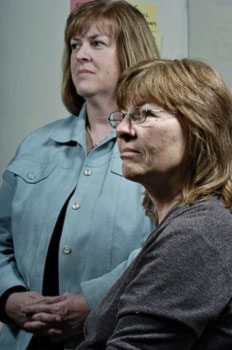Kids are smarter than adults give them credit for.
They know when their parents are fighting.
And they know where mommy’s black eye came from — even though the door was closed and they were supposed to be fast asleep, said victim’s services counsellor Jan Forde.
“Children have a sense when there’s violence in a home — whether they’re seeing it or just hearing it,” said Forde.
“They are aware of it 80 per cent of the time.”
And children who are exposed to violence indirectly often have the same symptoms as those who have been abused.
The Yukon’s Justice department has crafted a new program — Children Who Witness Domestic Violence — to deal with the symptoms of violence and address the needs of children who live with abuse in their homes.
These children usually suffer from depression, said Forde.
“They tend to blame themselves for what’s happening.”
They don’t know how to deal with what they’ve been exposed to, she added.
Like blue eyes or brown hair, abuse is often something that’s passed down from generation to generation in a family.
“We know that it’s a learned behaviour,” said Forde.
Children learn that violence is accepted family behaviour and often repeat it.
“As many as 75 per cent of boys who witnessed the abuse of a parent have demonstrable behaviour problems, are much more likely to be arrested by police and to engage in delinquent behaviour,” according to a report called The Domestic Violence Treatment Option: A Yukon Initiative.
“Girls in similar situations tend towards depression and may identify with their mothers and accept abusive behaviour as a norm in their lives.”
Early intervention is the best way to stop the cycle.
The new program is voluntary and open to children ages four to 18.
Children are referred to it through the Domestic Violence Treatment Option Court — an alternative justice program that works with offenders, counsellors, families and communities to curb domestic violence.
The program was crafted over the past few years and began accepting kids over the past few months.
Currently 22 families are involved.
The program, which is run by two dedicated counsellors, is kind of like a day camp, said victim services and family violence prevention unit manager Sandra Bryce.
Daily activities — such as hiking and games — will be tailored to the kids’ interests and age-level.
“It’s to help kids expand their view outside the home and it makes it safe for children to talk about things when they’re in a different setting,” said Bryce.
“It’s very, very flexible, which is good because I don’t think you’re going to retain families and children unless you’re somewhat flexible to their needs.”
At this point, the children’s program is a pilot project, but victim services co-ordinator Liz Candline hopes it will become a regular feature at victim’s services.
Before the program was developed there were other option for children facing abuse in the territory.
But they didn’t cover all children.
For example, Child Abuse Treatment Services offers programming, but under its intake guidelines there must be stability in the home.
That meant a segment of the population was being left out.
“For some of the children violence is still very much a part of their lives, those children were being missed,” said Candline.
And so the Children who Witness Domestic Violence program was developed to fill the gap.
In Canada, one in four women report that they were assaulted by a partner, according to Yukon Justice department figures.
Seventy-five per cent of those women were also emotionally abused.
And in 40 per cent of the cases, children witnessed domestic violence against their mothers.
People who live in northern Canada are more likely to be involved in domestic violence than their southern counterparts, according to a 2006 report Victimization and Offending in Canada’s Territories.
Nine per cent of Yukon residents reported being abused by their spouse in the past five years.
It is difficult to get clear statistics on spousal abuse in Canada because it often remains hidden, according to a Statistics Canada report.
Victims may be unable or unwilling to report abuse because they are emotionally dependent on their partners, they may feel ashamed, they may fear retaliation or they may feel stigmatized.
